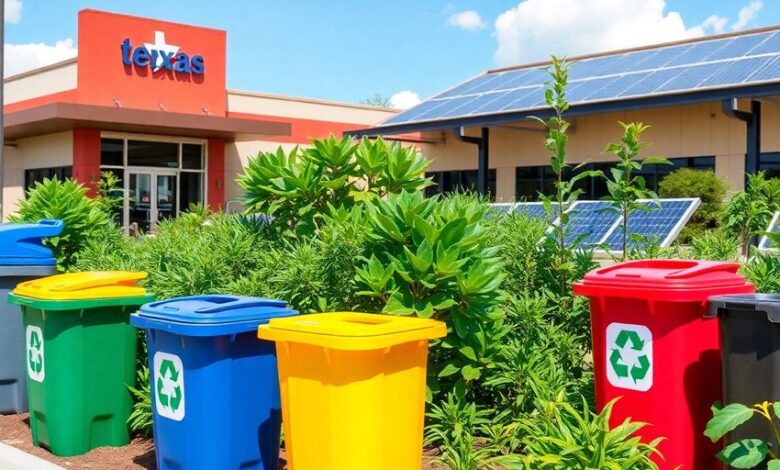
In Texas, businesses are increasingly recognizing the importance of sustainable waste management. As environmental concerns grow, adopting eco-friendly practices is not just a trend but a necessity. Companies in the Lone Star State are exploring innovative ways to minimize waste, reduce their environmental footprint, and contribute to a healthier planet. This article delves into various strategies that Texas businesses can implement to manage waste sustainably and operate more responsibly.
Key Takeaways
- Effective waste segregation is vital for reducing landfill waste and promoting recycling.
- Innovative recycling programs help create a circular economy and can enhance community engagement.
- Zero waste initiatives focus on minimizing waste and achieving sustainability goals, benefiting both the environment and businesses.
- Corporate sustainability practices can improve a company’s reputation and stakeholder engagement.
- Financial incentives are available to support businesses in adopting sustainable waste management strategies.
Effective Waste Segregation Techniques
Understanding Waste Streams
Okay, so first things first, you gotta know what kind of trash you’re dealing with. It’s not all just ‘garbage,’ you know? There’s recyclable stuff like paper, plastic, and glass. Then there’s organic waste – food scraps, yard trimmings, the usual suspects. And don’t forget the hazardous waste – batteries, chemicals, stuff that can really mess things up if you don’t handle it right. Knowing what you’re throwing away is the first step to actually sorting it properly.
Implementing Employee Training
Alright, so you know what types of waste you have. Now you need to get your employees on board. I mean, you can’t just expect them to magically know what goes where, right? You gotta train them. Make it clear, make it simple, and for Pete’s sake, make it mandatory. Color-coded bins are a must. Seriously, it’s like kindergarten all over again, but hey, it works. And maybe throw in some incentives, like a pizza party for the team with the least contamination. People love pizza.
Utilizing Technology for Sorting
Okay, so maybe you’re thinking, “Training? Color-coded bins? That’s so old school!” And you know what? You’re kinda right. Technology can make this whole waste segregation thing way easier. Think smart bins that tell you when they’re full. Or even better, AI-powered sorting machines that can separate recyclables faster and more accurately than any human. It might cost a bit upfront, but it’ll save you money (and headaches) in the long run. Plus, it’s just plain cool.
Waste segregation is not just about being environmentally responsible; it’s about being smart. It’s about reducing costs, improving efficiency, and creating a more sustainable business. And let’s be honest, it’s about looking good to your customers and stakeholders. So, get on board, Texas businesses. The future is green, and it starts with sorting your trash.
Innovative Recycling Programs
Recycling is more than just tossing cans into a blue bin. It’s about rethinking how we use resources and minimizing waste. Businesses in Texas can lead the charge by implementing innovative recycling programs that not only reduce their environmental impact but also create economic opportunities. It’s a win-win.
Creating a Circular Economy
The idea behind a circular economy is simple: keep resources in use for as long as possible. This means designing products for durability, repairability, and recyclability. Businesses can start by:
- Analyzing their product lifecycle to identify opportunities for waste reduction.
- Using recycled materials in their products.
- Offering take-back programs for customers to return used products for recycling or refurbishment.
By embracing a circular economy model, businesses can reduce their reliance on virgin materials, lower their carbon footprint, and create new revenue streams.
Partnerships with Recycling Organizations
Going it alone can be tough. Partnering with recycling practices can provide access to expertise, infrastructure, and markets for recycled materials. Consider these options:
- Collaborate with local recycling centers to ensure proper processing of recyclable materials.
- Work with specialized recyclers to handle difficult-to-recycle items like electronics or industrial waste.
- Join industry associations that promote recycling and resource recovery.
Promoting Community Recycling Initiatives
Businesses can extend their impact beyond their own operations by supporting community recycling initiatives. This could involve:
- Sponsoring local recycling events or collection drives.
- Providing educational resources to schools and community groups.
- Offering incentives for customers to recycle, such as discounts or rewards.
| Initiative | Description | Potential Impact |
|---|---|---|
| Recycling Bins | Providing clearly marked bins in public spaces | Increased recycling rates |
| Educational Workshops | Teaching the community about proper recycling | Reduced contamination |
| Community Clean-up Events | Organizing events to collect and recycle waste | Enhanced community engagement |
By actively engaging with the community, businesses can foster a culture of recycling and sustainability that benefits everyone. Finding the best firewood suppliers is important, but so is recycling!
Zero Waste Initiatives in Texas

Okay, so zero waste. It sounds like some impossible dream, right? But honestly, some businesses in Texas are really giving it a shot, and it’s pretty cool to see. It’s not just about recycling; it’s about rethinking how we use resources in the first place.
Defining Zero Waste Goals
First things first, what does “zero waste” even mean? It’s not literally zero waste, because that’s probably impossible. It’s more about diverting as much waste as possible from landfills and incinerators. The goal is usually around 90% diversion through things like reducing, reusing, recycling, and composting. Businesses need to set specific, measurable goals to even start. For example, a restaurant might aim to reduce food waste by 50% in a year.
Strategies for Achieving Zero Waste
Alright, so how do you actually do zero waste? It’s a multi-pronged approach, for sure. Here’s the gist:
- Waste Audits: Figure out what you’re throwing away in the first place. You can’t fix what you don’t measure.
- Reduce and Reuse: This is the big one. Can you use less packaging? Can you switch to reusable containers? Can you repair things instead of replacing them? Job opportunities in Region 13 can help you find the right people to implement these strategies.
- Recycling and Composting: Obvious, but important. Make sure you have a good recycling program and consider composting food scraps and other organic waste.
- Supplier Engagement: Work with your suppliers to reduce packaging and waste upstream.
Zero waste isn’t just about the environment; it’s about efficiency. When you reduce waste, you reduce costs. It’s a win-win.
Case Studies of Successful Zero Waste Businesses
Let’s talk about some real-world examples. There’s a brewery in Austin that sends its spent grain to local farms to be used as animal feed. A coffee shop in Dallas composts all its coffee grounds and food scraps. A manufacturing plant in Garland is finding the best dumpster rental rates to optimize waste disposal. These are just a few examples, but they show that zero waste is possible, even in Texas. It takes commitment, creativity, and a willingness to rethink how you do business. But the rewards are worth it.
Corporate Sustainability Practices

Integrating Sustainability into Business Models
It’s not just about being green anymore; it’s about weaving sustainability into the very fabric of how a business operates. This means rethinking processes, products, and even the company’s mission to align with environmental and social responsibility. For example, a business in Garland, Texas, might focus on sustainable waste management practices to minimize their environmental impact.
Measuring Environmental Impact
What gets measured, gets managed, right? Businesses need to understand their footprint to improve it. This involves:
- Conducting a thorough environmental audit.
- Tracking key performance indicators (KPIs) like energy consumption, water usage, and waste generation.
- Using software to monitor and report on sustainability metrics.
It’s important to remember that measuring environmental impact isn’t just about numbers. It’s about understanding the story those numbers tell and using that knowledge to make better decisions.
Engaging Stakeholders in Sustainability
Sustainability isn’t a solo act; it requires collaboration. Businesses should actively engage with:
- Employees: Get them involved in initiatives and solicit their ideas.
- Customers: Be transparent about your sustainability efforts and listen to their feedback.
- Suppliers: Work with them to improve the sustainability of your supply chain.
Here’s a simple table illustrating how different stakeholders can contribute:
| Stakeholder | Contribution |
|---|---|
| Employees | Suggesting waste reduction strategies |
| Customers | Choosing eco-friendly products |
| Suppliers | Providing sustainably sourced materials |
Green Transformation in Business Operations
It’s not just about being eco-friendly anymore; it’s about fundamentally changing how businesses operate. This involves integrating sustainable practices into every aspect of the company, from energy use to supply chains. It’s a big shift, but one that’s becoming increasingly necessary for long-term success.
Adopting Renewable Energy Solutions
Switching to renewable energy is a huge step. Many Texas businesses are now exploring solar, wind, and other renewable sources to power their operations. It’s not always easy or cheap upfront, but the long-term benefits, both environmentally and financially, can be significant. Austin businesses are embracing green energy solutions by investing in solar panels and other renewable energy technologies.
Implementing Energy Efficiency Measures
Beyond just switching to renewables, it’s important to use less energy in the first place. This can involve simple things like upgrading to energy-efficient lighting and appliances, but also more complex strategies like optimizing building design and using smart technology to manage energy consumption. Energy-efficient equipment helps to lower energy consumption and operational costs.
Here are some ways to improve energy efficiency:
- Upgrade to LED lighting.
- Install smart thermostats.
- Improve insulation.
Sustainable Supply Chain Management
Your business’s impact doesn’t stop at your doorstep. It extends to your entire supply chain. That means working with suppliers who share your commitment to sustainability, reducing waste in transportation, and ensuring ethical sourcing of materials. It’s about looking at the big picture and making sure every step of the process is as sustainable as possible.
Sustainable supply chain management is about integrating environmental and social considerations into the entire supply chain, from raw materials to end-of-life disposal. It requires collaboration with suppliers, customers, and other stakeholders to reduce environmental impact and promote ethical labor practices.
Community Engagement for Sustainable Practices
It’s not enough for businesses to just focus on their own internal sustainability efforts. To really make a difference, they need to get the community involved. This means partnering with local organizations, educating the public, and encouraging employees to volunteer. Community engagement is a cornerstone of successful sustainable practices.
Building Partnerships with Local Organizations
Businesses can’t do it alone. Teaming up with local environmental groups, non-profits, and even other businesses can amplify the impact of sustainability initiatives. These partnerships can take many forms, from sponsoring community clean-up events to collaborating on recycling programs. For example, a local grocery store could partner with a food bank to donate surplus food instead of throwing it away. Or, a construction company could work with a local conservation group to restore a degraded habitat. These collaborations not only benefit the environment but also strengthen community ties.
Participating in Environmental Education
Education is key to changing behaviors and fostering a culture of sustainability. Businesses can play a role by offering workshops, seminars, and educational materials to the public. This could include teaching people about the importance of recycling, composting, or conserving water. Companies can also partner with schools to develop environmental education programs for students. By investing in education, businesses can help create a more environmentally conscious community.
Encouraging Employee Volunteerism
Employee volunteerism is a great way to get employees involved in sustainability efforts and boost morale. Businesses can organize volunteer events, such as tree planting, park cleanups, or helping out at a local community garden. They can also offer employees paid time off to volunteer for environmental causes. By encouraging employee volunteerism, businesses can demonstrate their commitment to sustainability and empower their employees to make a difference. Austin businesses are deeply engaged in fostering community partnerships and social responsibility initiatives.
Engaging the community is not just about doing good; it’s also good for business. It can improve a company’s reputation, attract customers, and create a more engaged and productive workforce. By investing in community engagement, businesses can create a more sustainable future for themselves and for the planet.
Here’s an example of how volunteer hours can translate to impact:
| Activity | Volunteer Hours | Impact |
|---|---|---|
| Tree Planting | 100 | 500 Trees Planted |
| Park Cleanup | 50 | 20 Bags of Trash Removed |
| Recycling Drive | 75 | 1000 lbs of Recyclables Collected |
Financial Incentives for Sustainable Practices
Exploring Tax Rebates and Grants
Businesses in Texas that embrace sustainable practices aren’t just helping the environment; they can also tap into a range of financial incentives. These incentives often come in the form of tax rebates and grants, designed to encourage investment in eco-friendly technologies and processes. For example, regenerative agriculture practices can qualify small farms for grants. It’s worth doing some research to see what’s available at the state and federal levels.
- State tax credits for renewable energy installations.
- Federal grants for energy efficiency upgrades.
- Local rebates for water conservation measures.
Cost-Benefit Analysis of Sustainability Investments
Before jumping into any sustainability project, it’s smart to run a cost-benefit analysis. This helps you understand the long-term financial implications of your investment. While the initial costs of, say, installing solar panels or upgrading to more efficient equipment might seem high, the long-term savings on energy bills and potential tax benefits can make it a worthwhile investment. Don’t forget to factor in the positive impact on your brand reputation, which can attract environmentally conscious customers.
Leveraging Government Programs for Support
There are several government programs designed to support businesses in their sustainability efforts. These programs can provide financial assistance, technical support, and resources to help you implement eco-friendly practices. For example, the EPA’s WasteWise program offers recognition and assistance to companies committed to sustainable waste management practices. Take the time to explore these programs and see how they can help you achieve your sustainability goals while also improving your bottom line.
It’s important to remember that sustainability isn’t just about doing what’s right for the environment; it’s also about making smart business decisions. By taking advantage of financial incentives and government programs, you can create a more sustainable and profitable business.
Wrapping It Up
In conclusion, businesses in Texas, especially in places like Garland, really need to make sustainable waste management a top priority. By focusing on reducing waste and recycling, companies not only help the environment but also save money in the long run. Partnering with waste management experts can make this process smoother and more effective. As more businesses adopt these eco-friendly practices, they contribute to a healthier community and a cleaner planet. It’s clear that going green isn’t just good for the earth; it’s also a smart move for business growth and reputation.
Frequently Asked Questions
What is waste segregation and why is it important?
Waste segregation means sorting different types of waste into groups like recyclables, compost, and trash. It’s important because it helps reduce the amount of waste that goes to landfills and makes recycling easier.
How can businesses in Texas save money with waste management?
By properly sorting waste, businesses can lower their disposal costs. When they recycle materials, they can sometimes sell those recyclables, which can also bring in extra money.
What are some common recycling programs for businesses?
Many businesses start recycling programs by collecting paper, plastics, and metals separately. They might also partner with local recycling centers to make the process easier.
What does it mean to have a zero waste initiative?
A zero waste initiative aims to reduce waste to the point where almost nothing goes to landfills. This means reusing materials, recycling everything possible, and composting organic waste.
How can companies engage their employees in sustainability efforts?
Companies can involve employees by providing training on recycling and waste management, encouraging them to participate in community clean-up events, and recognizing their efforts in sustainability.
Are there financial incentives for businesses that practice sustainability?
Yes, many Texas businesses can access tax rebates, grants, and other incentives for adopting sustainable practices. These can help offset costs and encourage eco-friendly actions.



